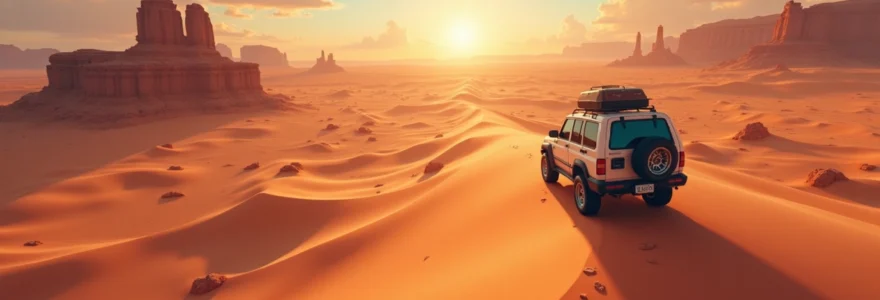Arid landscapes have captivated explorers and adventurers for centuries, offering a stark beauty and unique challenges unlike any other environment on Earth. From the vast expanse of the Sahara to the otherworldly terrain of the Atacama, deserts present an opportunity for travellers to test their limits and experience some of the planet’s most extraordinary ecosystems. As climate change reshapes these delicate environments, the allure of desert exploration has never been more compelling.
Geological formations and ecosystems of arid landscapes
Desert landscapes are far more diverse than the stereotypical image of endless sand dunes might suggest. These arid regions are home to a wide variety of geological formations, each sculpted by wind, water, and time. Towering mesas, deep canyons, and expansive salt flats are just a few examples of the dramatic features that characterise desert terrains.
One of the most fascinating aspects of desert ecosystems is their remarkable adaptability. Plants and animals in these harsh environments have evolved unique strategies to survive with minimal water and extreme temperature fluctuations. Cacti, for instance, have developed thick, waxy skin to retain moisture, while many desert animals are nocturnal to avoid the scorching daytime heat.
Despite their apparent barrenness, deserts are teeming with life. Biodiversity hotspots can be found in unexpected places, such as ephemeral rivers and hidden oases. These pockets of life support complex food webs and provide crucial resources for both resident and migratory species.
The desert is a natural extension of the inner silence of the body.
Essential gear and technologies for desert exploration
Venturing into the desert requires careful preparation and specialised equipment. The harsh conditions demand gear that can withstand extreme temperatures, abrasive sand, and prolonged exposure to intense sunlight. Seasoned desert travellers know that the right equipment can mean the difference between a successful expedition and a potentially dangerous situation.
Advanced GPS and satellite communication devices
Navigation in the featureless expanse of a desert can be challenging, even for experienced explorers. Modern GPS devices with desert-specific mapping capabilities are essential tools for maintaining orientation and plotting routes. Additionally, satellite communication devices provide a crucial lifeline in areas where traditional cell phone networks are non-existent.
These technologies not only enhance safety but also allow for more ambitious explorations into remote areas. Real-time tracking and SOS functionality offer peace of mind for both travellers and their support teams back home.
High-performance moisture-wicking fabrics and UV protection
Clothing designed for desert environments plays a vital role in regulating body temperature and preventing dehydration. Advanced moisture-wicking fabrics draw sweat away from the skin, promoting evaporative cooling. These materials, often made from synthetic blends or merino wool, help maintain comfort in scorching temperatures.
UV protection is equally crucial, given the intense solar radiation in desert regions. UPF-rated clothing, wide-brimmed hats, and high-SPF sunscreens are non-negotiable items for any desert traveller. Long-sleeved shirts and pants, despite seeming counterintuitive in hot climates, provide essential protection against both sun and wind-blown sand.
Water purification and storage systems for extreme conditions
In the desert, water is life. Carrying sufficient water for extended trips can be impractical, making water purification systems essential. Modern portable filters and chemical treatments can render even brackish water safe for consumption. Hydration bladders and insulated water bottles help keep precious water cool and easily accessible.
Innovative water harvesting techniques are also gaining popularity among desert explorers. These may include condensation traps or specially designed tarps that collect dew, providing a supplementary water source in dire situations.
Specialised desert vehicles and off-road driving techniques
Traversing vast desert landscapes often requires specialised vehicles equipped to handle soft sand, rocky terrain, and extreme heat. Four-wheel-drive vehicles with high ground clearance, reinforced suspension, and enhanced cooling systems are standard for serious desert expeditions.
Mastering off-road driving techniques is crucial for navigating desert terrain safely. Skills such as sand driving , dune cresting , and winch operation are essential for any driver venturing into the desert. Many adventure travel companies offer courses in desert driving, combining theoretical knowledge with practical experience in controlled environments.
Navigating the sahara: trekking through the world’s largest hot desert
The Sahara Desert, covering an area roughly the size of the United States, presents a formidable challenge to even the most seasoned explorers. Its vast expanse of sand dunes, rocky plateaus, and ancient dried lakebeds offers a diverse range of landscapes and experiences for intrepid travellers.
Tuareg-guided camel caravans across the erg chebbi dunes
One of the most authentic ways to experience the Sahara is through a traditional camel caravan led by Tuareg guides. The Tuareg, often referred to as the “Blue People” due to their indigo-dyed clothing, have traversed the Sahara for centuries and possess an unparalleled knowledge of the desert’s secrets.
The Erg Chebbi dunes in Morocco offer a stunning backdrop for these camel treks. As you sway atop your dromedary mount, you’ll witness the ever-changing colours of the sand as the sun arcs across the sky. Nights spent camping under the stars provide an opportunity to experience the profound silence and dark skies that only the deep desert can offer.
Exploring the ancient salt mines of taghaza
The abandoned salt mines of Taghaza in northern Mali stand as a testament to the Sahara’s rich trading history. Once a crucial source of salt for trans-Saharan caravans, Taghaza now offers explorers a glimpse into the past. The eerily beautiful landscape of eroded salt formations and ancient mining pits creates an otherworldly atmosphere.
Visiting Taghaza requires careful planning and local expertise due to its remote location and the challenging political situation in the region. However, for those who make the journey, it provides a unique perspective on the economic forces that have shaped the Sahara for millennia.
Stargazing in the sahara Dark-Sky reserve
The Sahara’s vast, unpolluted skies offer some of the best stargazing opportunities on the planet. In recent years, efforts have been made to establish dark-sky reserves in parts of the desert to protect these pristine viewing conditions.
Equipped with powerful telescopes and guided by knowledgeable astronomers, you can observe celestial bodies with exceptional clarity. The experience of witnessing the Milky Way stretch across the horizon, unobscured by artificial light, is truly awe-inspiring.
In the desert, you can remember your name.
Atacama desert: astronomical observatories and otherworldly landscapes
The Atacama Desert in Chile is renowned for its otherworldly landscapes and unparalleled stargazing conditions. As one of the driest places on Earth, with some areas receiving no measurable rainfall for decades, the Atacama offers a unique environment for both scientific research and adventure tourism.
The high-altitude plateaus of the Atacama are home to some of the world’s most advanced astronomical observatories. The lack of atmospheric moisture and light pollution creates ideal conditions for studying the cosmos. Visitors can tour facilities like the Alma Observatory , which houses a vast array of radio telescopes, and participate in guided stargazing sessions that reveal the southern sky in breathtaking detail.
Beyond its astronomical wonders, the Atacama’s landscape features a diverse array of geological formations. The Valle de la Luna (Moon Valley) lives up to its name with its lunar-like terrain of salt caves, sand dunes, and rugged stone formations. Nearby, the El Tatio geyser field offers a surreal experience as steam plumes rise against the backdrop of the Andes mountains in the early morning light.
For adventure seekers, the Atacama provides opportunities for sandboarding down massive dunes, mountain biking through rocky canyons, and hiking to hidden lagoons high in the Andean foothills. The contrast between the stark desert landscape and the occasional burst of life, such as the flamingos that inhabit the salt flats, adds to the Atacama’s allure as a destination like no other on Earth.
Survival techniques and indigenous knowledge in desert environments
Desert survival has been honed over millennia by indigenous peoples who have learned to thrive in these challenging environments. Their accumulated knowledge offers valuable insights for modern explorers and scientists studying arid ecosystems.
Traditional bedouin water-finding methods in the arabian desert
The Bedouin people of the Arabian Desert have developed sophisticated techniques for locating water in seemingly barren landscapes. These methods often rely on keen observation of natural indicators such as the presence of certain plants or the behaviour of animals.
One traditional technique involves digging for water in dry riverbeds or at the base of certain rock formations where moisture is likely to accumulate. The Bedouin also practise water conservation methods, such as travelling at night to reduce water loss through perspiration and using every part of their livestock to minimise waste.
Aboriginal bush tucker foraging in the australian outback
Australia’s Indigenous peoples have a deep understanding of the desert’s hidden bounty. Their knowledge of bush tucker – native plants and animals that can be used for sustenance – has allowed them to survive in the harsh conditions of the Outback for tens of thousands of years.
Edible plants like the quandong (desert peach) and bush tomato provide vital nutrients and moisture. Indigenous guides now share this knowledge with visitors, teaching them how to identify and prepare these desert delicacies safely.
Navajo sand painting and its connection to desert ecology
The Navajo people of the American Southwest have a rich tradition of sand painting, which not only serves as a form of artistic expression but also reflects a deep understanding of desert ecology. The materials used in these intricate designs – various coloured sands, pollens, and crushed minerals – are sourced from the desert environment.
Through the creation and study of sand paintings, Navajo artists and healers pass down knowledge about the interrelationships between different desert plants, animals, and geological features. This holistic view of the desert ecosystem informs sustainable practices and resource management.
Desert navigation using celestial bodies and natural landmarks
Before the advent of GPS technology, desert travellers relied on celestial navigation and keen observation of natural landmarks to find their way. Many indigenous cultures developed sophisticated systems for orientation based on the positions of stars, the sun, and distinctive geological features.
Learning these traditional navigation techniques not only provides a backup in case of technology failure but also deepens one’s connection to the desert environment. Understanding how to read the landscape and sky can enhance the overall experience of desert exploration, allowing travellers to move through the terrain with greater confidence and awareness.
Climate change impacts on desert ecosystems and adventure tourism
As global temperatures rise, desert ecosystems are experiencing significant changes that affect both their delicate balance of life and the opportunities for adventure tourism. Increased temperatures and altered precipitation patterns are reshaping these arid landscapes in ways that present new challenges and considerations for travellers and conservationists alike.
One of the most noticeable impacts is the intensification of extreme weather events. Flash floods, once rare occurrences in many desert regions, are becoming more frequent and severe. These events can dramatically alter the landscape, carving new canyons and reshaping dune fields overnight. For adventure tourists, this means a need for greater vigilance and flexibility in planning desert expeditions.
The changing climate is also affecting the distribution and behaviour of desert flora and fauna. Some species are migrating to higher elevations or latitudes in search of more suitable conditions, while others face the threat of extinction. This shift in biodiversity has implications for wildlife viewing opportunities and the overall ecological experience of desert travel.
On the other hand, climate change is opening up new possibilities for adventure tourism in some desert regions. As traditional snow-based winter activities become less reliable in many parts of the world, desert destinations are increasingly being promoted as year-round adventure hubs. Activities like dune skiing and desert marathons are gaining popularity, offering unique experiences that blend the thrill of extreme sports with the stark beauty of arid landscapes.
However, the increased interest in desert tourism also raises concerns about sustainability and the potential for environmental degradation. As more travellers venture into these fragile ecosystems, there is a growing need for responsible tourism practices and education about the desert’s ecological importance.
Researchers and tour operators are now collaborating to develop adaptive strategies that balance the desire for desert adventures with the need to protect these unique environments. This includes the use of advanced weather forecasting technologies, the implementation of strict leave-no-trace policies, and the development of eco-friendly accommodation options that minimise impact on the surrounding landscape.
As climate change continues to reshape our planet’s deserts, the adventure tourism industry must evolve to meet new challenges while preserving the essence of what makes these arid landscapes so captivating. The future of desert travel will likely involve a delicate balance between innovation, conservation, and respect for the ancient wisdom of those who have long called these harsh yet beautiful environments home.


